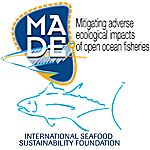Can stable isotopes document trophic position, diet, and movement in pelagic sharks? Case studies in the Atlantic and Indian Oceans
1 : UMR EME
IRD
2 : UMR LEMAR
IRD
3 : ECOMAR
Université La Réunion
4 : IMAR
5 : UCT
6 : APECS
* : Corresponding author
APECS
The blue shark Prionace glauca and the silky shark Carcharhinus falciformis are the two main shark by-catch in pelagic longline and purse seine fisheries, respectively. The high market demand for shark fins is currently the main driver of unsustainable fishing for sharks globally, with potential effects on ecosystem trophic functioning through top-down cascading effects. Knowledge of the species' trophic ecology is therefore crucial but is limited by the lack of data (e.g. stomach-content data). Stable isotope analysis was then performed on muscle tissues (delta-N-15 and delta-C-13) of these two shark species collected in the western Indian and the eastern Atlantic Oceans in order to examine their trophic positions and movement patterns. For the two species, we investigated body length, season, and zone effects on isotope signatures. In addition, we took into account the effect of the fishing gear (longline and purse seine sets made around floating objects, i.e. Fish Aggregating Devices) to explain the different patterns in the Indian Ocean. Our findings suggest niche partitioning between species, with silky sharks having a more inshore foraging habitat than blue sharks. We also interpreted the trophic position of these species in the light of other large predatory fishes in both oceans.

 PDF version
PDF version
